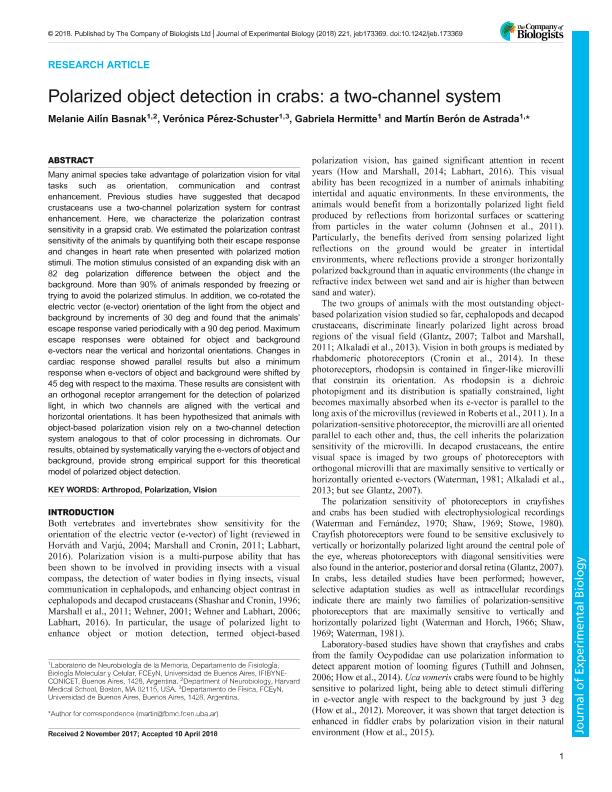Mostrar el registro sencillo del ítem
dc.contributor.author
Basnak, Melanie Ailin

dc.contributor.author
Pérez Schuster, Verónica

dc.contributor.author
Hermitte, Gabriela

dc.contributor.author
Berón de Astrada, Martín

dc.date.available
2019-11-20T22:06:19Z
dc.date.issued
2018-05
dc.identifier.citation
Basnak, Melanie Ailin; Pérez Schuster, Verónica; Hermitte, Gabriela; Berón de Astrada, Martín; Polarized object detection in crabs: a two-channel system; Company of Biologists; Journal of Experimental Biology; 221; 5-2018; 1-11
dc.identifier.issn
0022-0949
dc.identifier.uri
http://hdl.handle.net/11336/89333
dc.description.abstract
Many animal species take advantage of polarization vision for vital tasks such as orientation, communication and contrast enhancement. Previous studies have suggested that decapod crustaceans use a two-channel polarization system for contrast enhancement. Here, we characterize the polarization contrast sensitivity in a grapsid crab. We estimated the polarization contrast sensitivity of the animals by quantifying both their escape response and changes in heart rate when presented with polarized motion stimuli. The motion stimulus consisted of an expanding disk with an 82 deg polarization difference between the object and the background. More than 90% of animals responded by freezing or trying to avoid the polarized stimulus. In addition, we co-rotated the electric vector (e-vector) orientation of the light from the object and background by increments of 30 deg and found that the animals' escape response varied periodically with a 90 deg period. Maximum escape responses were obtained for object and background e-vectors near the vertical and horizontal orientations. Changes in cardiac response showed parallel results but also a minimum response when e-vectors of object and background were shifted by 45 deg with respect to the maxima. These results are consistent with an orthogonal receptor arrangement for the detection of polarized light, in which two channels are aligned with the vertical and horizontal orientations. It has been hypothesized that animals with object-based polarization vision rely on a two-channel detection system analogous to that of color processing in dichromats. Our results, obtained by systematically varying the e-vectors of object and background, provide strong empirical support for this theoretical model of polarized object detection.
dc.format
application/pdf
dc.language.iso
eng
dc.publisher
Company of Biologists

dc.rights
info:eu-repo/semantics/openAccess
dc.rights.uri
https://creativecommons.org/licenses/by-nc-sa/2.5/ar/
dc.subject
Vision
dc.subject
Polarized light
dc.subject
Arthropod
dc.subject.classification
Otras Ciencias Biológicas

dc.subject.classification
Ciencias Biológicas

dc.subject.classification
CIENCIAS NATURALES Y EXACTAS

dc.title
Polarized object detection in crabs: a two-channel system
dc.type
info:eu-repo/semantics/article
dc.type
info:ar-repo/semantics/artículo
dc.type
info:eu-repo/semantics/publishedVersion
dc.date.updated
2019-10-21T19:13:36Z
dc.identifier.eissn
1477-9145
dc.journal.volume
221
dc.journal.pagination
1-11
dc.journal.pais
Reino Unido

dc.journal.ciudad
Cambridge
dc.description.fil
Fil: Basnak, Melanie Ailin. Consejo Nacional de Investigaciones Científicas y Técnicas. Oficina de Coordinación Administrativa Ciudad Universitaria. Instituto de Fisiología, Biología Molecular y Neurociencias. Universidad de Buenos Aires. Facultad de Ciencias Exactas y Naturales. Instituto de Fisiología, Biología Molecular y Neurociencias; Argentina
dc.description.fil
Fil: Pérez Schuster, Verónica. Consejo Nacional de Investigaciones Científicas y Técnicas. Oficina de Coordinación Administrativa Ciudad Universitaria. Instituto de Fisiología, Biología Molecular y Neurociencias. Universidad de Buenos Aires. Facultad de Ciencias Exactas y Naturales. Instituto de Fisiología, Biología Molecular y Neurociencias; Argentina
dc.description.fil
Fil: Hermitte, Gabriela. Consejo Nacional de Investigaciones Científicas y Técnicas. Oficina de Coordinación Administrativa Ciudad Universitaria. Instituto de Fisiología, Biología Molecular y Neurociencias. Universidad de Buenos Aires. Facultad de Ciencias Exactas y Naturales. Instituto de Fisiología, Biología Molecular y Neurociencias; Argentina
dc.description.fil
Fil: Berón de Astrada, Martín. Consejo Nacional de Investigaciones Científicas y Técnicas. Oficina de Coordinación Administrativa Ciudad Universitaria. Instituto de Fisiología, Biología Molecular y Neurociencias. Universidad de Buenos Aires. Facultad de Ciencias Exactas y Naturales. Instituto de Fisiología, Biología Molecular y Neurociencias; Argentina
dc.journal.title
Journal of Experimental Biology

dc.relation.alternativeid
info:eu-repo/semantics/altIdentifier/url/https://jeb.biologists.org/content/221/10/jeb173369.long
dc.relation.alternativeid
info:eu-repo/semantics/altIdentifier/doi/http://dx.doi.org/10.1242/jeb.173369
Archivos asociados
